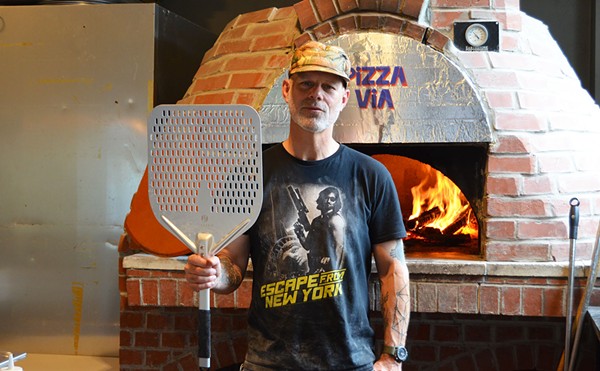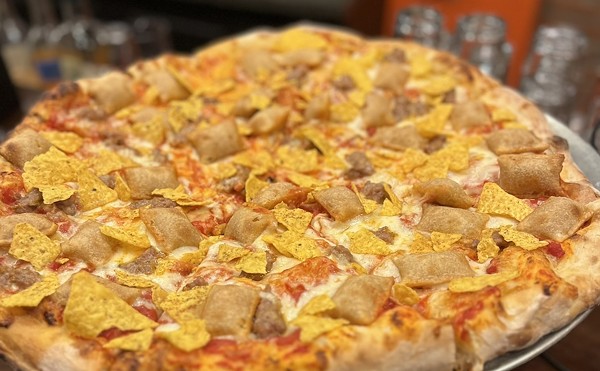When all was said and done, we had visited four local restaurants that specialize, completely or in part, in Korean food. We're aware of two more from past experience, and we're tantalized by reports that at least two local places better known for Americanized Chinese staples will produce separate menus of Korean (and Chinese) delicacies on request. Unable to verify this, however, we will leave discussion of those last two restaurants for a later date.
In general, the consistent motif at local Korean restaurants seems to be that they are family-run and feature austere dining rooms. This pattern dates back to the pioneer of local Korean food, Choi's, which started out in a hole-in-the-wall on Meramec Street in South St. Louis before moving out to a space at Dorsett Boulevard and I-270, changing owners and adopting more of a focus on Filipino and Japanese food (while still retaining a short list of Korean specialties).
Another interesting aspect of Korean restaurants in St. Louis is that they often have multiple names. Our first stop is listed as Hangook Kwan in the phone book but also has signage calling it Korea House.
We first visited Hangook Kwan shortly after it opened a few years ago at the corner of Olive and Fee Fee, and we came away with a bad taste -- not from the food but from a tyrannical hostess/waitress who wouldn't let us order anything but kun man doo (dumplings) and bulgoki (marinated, barbecued beef) while others around us, apparently ethnic Koreans, were chowing down on all sorts of interesting alternatives.
Luckily, the two young Korean women who waited on us this time were completely cordial, encouraging us to pick whatever we wanted and offering succinct but thorough descriptions of items that interested us. Despite our country-European heritage, we shied away from the elaborate soup dishes based on tripe and intestines, settling on goh deong un goo yih (mackerel) and khal bee (beef ribs) as our entrées. (I apologize in advance if my handwritten notes resulted in any transcription mistakes in the dishes' names; moreover, because there are few standards for transliterating the Korean character set, the anglicization of the dish names varies even from restaurant to restaurant.)
The beef ribs, served on a cast-iron plate with lots of onions, in a manner parallel to how many Mexican restaurants present their fajitas, were served on-bone, cut into more than a dozen inch-or-so pieces. With the exception of the more sinewy portions, the meat fell off the bone, salty with a touch of sweetness. The mackerel still had bones, but these were easy to work around, and the cooking left a crispy, slightly chewy skin on the fish, with an intense but not overly fishy flavor to the flesh.
All of the restaurants we visited featured pan chan, a selection of side dishes in small round bowls. At Hangook Kwan these pan chan consisted of bean sprouts lightly dressed in sesame oil; lightly sauced seaweed; the ubiquitous kimchee, pickled cabbage liberally dosed with hot red pepper; and our favorite of this group, a preparation of dried squid that had overtones of ham or bacon.
Next it was on to Seoul Garden, located on St. Charles Rock Road just east of Northwest Plaza. Although the restaurant's business card notes that it serves Chinese and Japanese food in addition to Korean, the dinner menu appeared to comprise almost exclusively Korean dishes, and it was also the lengthiest menu of all the restaurants we visited, including a selection of hot pots and casseroles for multiple diners in the $25-$30 range, as well as a giant banquet featuring a variety of common and unusual meat dishes for $79.95.
For whatever reason, here we focused on seafood, sampling the mee un sae woo bokum (sautéed shrimp) and the augu jjam (monkfish and sprout stew). Our order of the latter was accepted with the warning "It's very spicy," but in this case, at least, our Western palates weren't overwhelmed by the hot pepper. The monkfish, sliced into steaks, retained the dense texture that often earns it the title "poor man's lobster." The accompanying sauce combined the heat of the pepper with overtones of fish stew, and the accompanying bean sprouts were much larger than I expected. The shrimp dish was OK but nothing special, about a dozen medium shrimp mixed with lots of vegetables in a mild garlic sauce.
Side dishes here were more focused on variants of pickled peppering, with both shredded and cubed daikon radish and cabbage served in this style, as well as a nonhot side of marinated sprouts.
Korea Garden, another of the Korean restaurants-of-many-names (appearing on the outside as Peking Inn), is located at the eastern edge of a strip mall just off Olive Boulevard, a few blocks east of I-270. Korea Garden features a couple dozen selections, divided into rice and noodles, seafood, meat, stews and soups. This restaurant was probably our favorite of the four, laying it on heavy with the red pepper and introducing us to a new flavor combination in sam gae tank, a ginseng-spiked soup of Cornish game hen stuffed with rice and dates. Because this is basically a stewed hen, the meat was expectedly floppy and mild, with hints of anise flavor and sweetness from the ginseng and dates.
We were also quite taken with the pa jun, a seafood-and-scallion omelet listed as an appetizer (and a "pancake") but easily converted into a main course (and much more eggy than cakey). The main seafood ingredient was squid, but it was cut and cooked such that it was quite tender -- almost like a scallop in texture -- and each successive bite offered not just a mild onion overtone but also a lingering aftertaste of very hot red pepper.
The pan chan here numbered five and were the most adventuresome of the group, including kimchee, a cake of fish and tofu, julienned zucchini, a sweetened egg not unlike tamago sushi, and spicy squid.
Of course, we had to check back in at Choi's, which now offers only bulgoki and bibimbap as remnants of its original Korean heritage. Choi certainly has the nicest dining room of the four, with paper window shades at the front and a bright-green color scheme. The bulgoki was quite enjoyable, cut into almost razor-thin slices and thus, with cooking, taking on the texture of beef jerky, but it was easily chewed and finished with both saltiness and sweetness. The bibimbap, served in a small cast-iron cauldron, included spinach, sprouts, shredded carrots, radish and beef topped with a fried egg, designed to be all mixed together along with gochu jang, a paste of chile pepper. The beef was a bit of a disappointment, with the slices apparently stewed and not at all seared, resulting in blandness, but the mixture, especially with the chile sauce, was a rich combination.
Two other places in town at which to sample Korean food that we didn't visit this time around are the U-City Grill (6696 Enright Ave.) and Shu Feng (8435 Olive Blvd.). The U-City Grill is a classic old-fashioned griddle-and-counter diner, serving up working-class breakfasts and lunches but also offering bibimbap and about a half-dozen other Korean specialties from an alternative lunch menu. Shu Feng was featured on these pages earlier this year, when Jill Posey-Smith enthused, "The red-hot kimchee fried rice is aces, and I double-dare you to try the braised sea cucumber."
So if you'd like to get to know this "least-known great Asian cuisine" a bit better, you certainly have a range of choices locally. Best case, go with a big group and try an assortment of new things.





